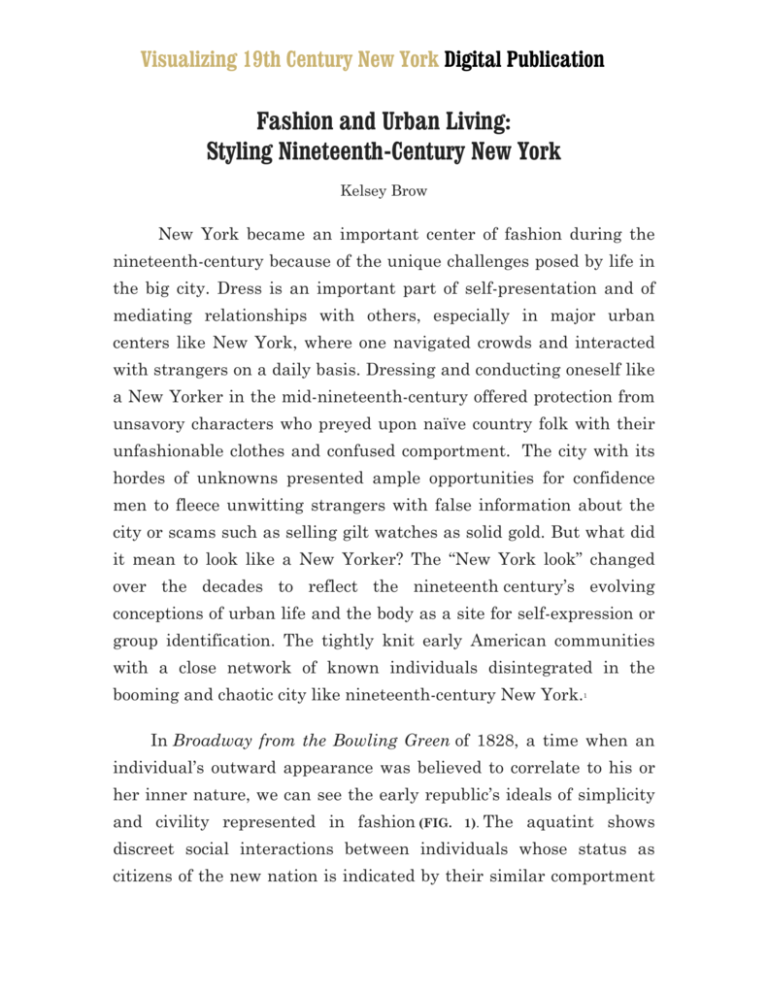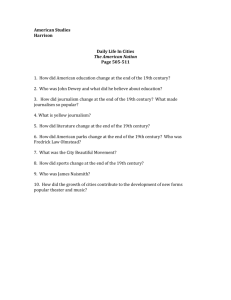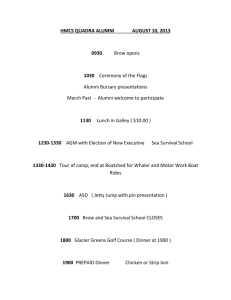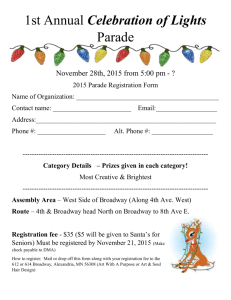Fashion and Urban Living: Styling Nineteenth
advertisement

Visualizing 19th Century New York Digital Publication Fashion and Urban Living: Styling Nineteenth-Century New York Kelsey Brow New York became an important center of fashion during the nineteenth-century because of the unique challenges posed by life in the big city. Dress is an important part of self-presentation and of mediating relationships with others, especially in major urban centers like New York, where one navigated crowds and interacted with strangers on a daily basis. Dressing and conducting oneself like a New Yorker in the mid-nineteenth-century offered protection from unsavory characters who preyed upon naïve country folk with their unfashionable clothes and confused comportment. The city with its hordes of unknowns presented ample opportunities for confidence men to fleece unwitting strangers with false information about the city or scams such as selling gilt watches as solid gold. But what did it mean to look like a New Yorker? The “New York look” changed over the decades to reflect the nineteenth century’s evolving conceptions of urban life and the body as a site for self-expression or group identification. The tightly knit early American communities with a close network of known individuals disintegrated in the booming and chaotic city like nineteenth-century New York. 1 In Broadway from the Bowling Green of 1828, a time when an individual’s outward appearance was believed to correlate to his or her inner nature, we can see the early republic’s ideals of simplicity and civility represented in fashion (FIG. 1). The aquatint shows discreet social interactions between individuals whose status as citizens of the new nation is indicated by their similar comportment 2 Brow and costume. Republican modes of dress enabled individuals to identify themselves as participants in a group of social equals who were similarly versed in the standards of proper behavior. Men, women, and children are dressed in simple, carefully tailored clothing, and both sexes are models of self-discipline and modesty. Slim lines with no fussy ornamentation suggest restraint; the narrowly cut garments that force the shoulders back and the chest out insure such restraint, while upright carriage emphasizes a robust form. FIG. 1 J. R. Hutchinson, after J. Bennett.Broadway from the Bowling Green, 1828, 1828. Hand-colored etching. Eno Collection, Miriam and Ira D. Wallach Division of Art, Prints and Photographs, The New York Public Library, Astor, Lenox and Tilden Foundations. Visualizing 19th Century New York Digital Publication 3 Brow FIG 2 Anthony Imbert, after Edward Williams Clay. Life in New York: The Inconveniency of Tight Lacing, St. John’s Park,1829. Lithograph. Picture Collection, The New York Public Library, Astor, Lenox and Tilden Foundations. With the completion of the Erie Canal, New York boomed and city boosters boasted of the Empire City. No longer was republican austerity suitable; city dwellers wanted “‘embellishment[s]’ which might ‘give [New York] fair claim to rank among the most elegant cities in the world.’” Fashions of the 1830s reached new heights of 2 ornamentation—quite literally. The bell-shaped skirts, giant puffed sleeves, and intricate, towering hairstyles of the Romantic era tended to expand a person’s physical presence in dramatic contrast to the self-consciously bound bodies of republican gentility. The dandies in Anthony Imbert’s 1829 print Life in New York: The Inconveniency of Tight Lacing walk with overly long strides near St. John’s Park dressed in over-the-top suits accessorized with large top hats (FIG. 2). The tightly fitting jacket makes it difficult for one of the Visualizing 19th Century New York Digital Publication 4 Brow men to tie his shoelaces. The dandies in this “Life in New York” series of prints show how fashion and social mores could be purposefully exaggerated or subverted to reflect group identity. Through his satire of this counter-cultural behavior, Imbert also pokes fun at the society at large. The highly emotional quality of Romantic dress and accompanying modes of behavior encouraged grandiose expressions of sentiment, which came to be seen as false and insincere and engendered a strong reaction during the 1830s and 1840s. FIG. 3 D. Appleton & Co. Interior view of the D. Appleton & Co. Stereoscopic Emporium, 346 and 348 Broadway, New York. Dealer in every kind of Stereoscopic Views & Instruments, Domestic & Imported, ca. 1860. Hand-colored albumen prints from glass negatives (stereoscopic views). The Jeffrey Kraus Collection, www.antiquephotographics.com. Sentimental fashions of the 1840s claimed that beauty lay in transparency, by which the soul was revealed. For an example of sentimental fashion, see Interior view of the D. Appleton & Co. Stereoscopic Emporium, 346 and 348 Broadway, New York. (FIG. 3). Note the restrained character of the woman’s dress, with few embellishments to distract from the wearer’s natural beauty. The Visualizing 19th Century New York Digital Publication 5 Brow face is framed by pulling the hair back over the ears. An attractive woman “sheds an uplifting moral appearance,” and as women were the safeguarders of morality, each had a responsibility to cultivate her own beauty. Magazines such as Godey’s Lady’s Book (1830–78) 3 suggested ways in which women of means or otherwise could dress so that their outward appearance would best reveal their inner beauty. The pursuit of fashion, previously considered antithetical to republican values, therefore became rationalized through the need to obtain certain articles of clothing that enhanced the transparency of a woman’s appearance and to discard those deemed to hide or conceal. The idea of clothing as revealing one’s inner beauty, a 4 vague notion at best, was easily muddled with dressing to set off one’s physical beauty, and styles of following decades reintroduced selective embellishments and accessories to display or enhance the wearer’s appearance. With the republican ideal of virtue in simplicity thus discarded in favor of consumerism, shopping became an appropriate venue for the display of sociability. Broadway, the city’s “principal thoroughfare, and most fashionable promenade,” was the epicenter of commercial and social activity. As 5 historian David Scobey put it, the fashionable promenade celebrated social distinction through public display, in which “seeing and being seen offered a means of sanctioning the new inequalities of New York’s financial boom, creating a stage on which wealth, refinement and ‘character’ could be elided.” In 1825 the New 6 York Mirror published the following comments: “Then . . . on the ‘fashionable [west] side,’ you will see New York’s possible in the way of beautiful women, scrupulously-dressed dandies, and pretty children. It is only at this hour of the day that the distinction between the east and the west side [of Broadway] is imperative. In Visualizing 19th Century New York Digital Publication 6 Brow the morning, or at midday . . . you may take the sidewalk most shady or convenient without positive loss of character. But at grand promenade hour, wo[e] be to the unhappy wight or distressed damsel who should be seen plodding along the shilling pavement!” 7 FIG. 4 W. S. L. Jewett. “Broadway.” From Harper’s Weekly, February 15, 1868. Library, Bard Graduate Center. Photographer: Bruce White. New York City has always represented a great imbalance of wealth (in 1800, the richest 20 percent of New York’s population owned almost 80 percent of the city’s wealth), but that disparity only worsened throughout the nineteenth century and resulted in the rhetoric of a city of “light and shadows.” By the 1860s, the Empire 8 City was a deeply divided one. Images such as the 1868 woodcut from Harper’s Weekly depict the deep divisions among the crowds interacting on Broadway (FIG. 4). The well-dressed individuals generally look down their noses in order to avoid interacting with those they considered their inferiors. A woman in plain, dark clothes and wrapped in a shawl appears to be clutching a baby to her chest Visualizing 19th Century New York Digital Publication ! 7 Brow as she receives a few coins from a beribboned stranger, contrasting with the fashionable ladies in the foreground, who present an example of dress for urban living. Their skirts just graze the ground and fall in soft folds, a gentle perimeter around their bodies giving the impression of gliding as they effortlessly navigate the crowded streets of New York. Model New Yorkers, they wear rich yet unobtrusive clothing, embodying the nineteenth-century character of the savvy urbanite who stands apart from the overstated pretensions of small-town society and the boisterous, plebeian promenade on the Bowery. As the economic gap between the classes increased, so did the importance of comportment and clothing to class identification. FIG. 5 Thomas Hogan. “Up Among the Nineties.” From Harper’s Weekly, August 15, 1868. Library, Bard Graduate Center. Photographer: Bruce White. In a society that espoused democratizing values and increasingly affordable clothing, the New York elite tried to stay one step ahead, moving on to a different fashion as soon as the previous trend had been taken up by those with less social clout. While Visualizing 19th Century New York Digital Publication 8 Brow fashion magazines insisted that good taste could overcome a lack of money when fitting up one’s wardrobe and offered hints for dressing beautifully “on the cheap, ” not everyone could afford to dress like the plates printed in Godey’s, nor did everyone want to do so. Many working-class people rejected emulation of the upper classes, developing instead a plebeian language of fashion, not unlike the earlier dandies, often exaggerating the latest modes and wearing bold colors. Those who espoused countercultural fashions also held different ideas about the ideals of urban social life. The Bowery set’s conception of public space tended to be less restrained than the mode of refinement so central to elite New York socialization. Note the restrained expressions of the well-dressed ladies and the unselfconscious ragged children in “Up Among the Nineties” (FIG. 5). Each group engages in the same activity, but their clothing, comportment, and the setting mark them as irreconcilably unequal. Adhering to certain codes of conduct and modes of dress enabled individuals to identify themselves as participants in a group of social equals—and to avoid interacting with those who weren’t—so rejecting that kind of dress and behavior was a way to challenge the cultural dominance of the upper classes. Although department store owners like A. T. Stewart at first intended to court elite society, by the 1860s these commercial palaces found an eager clientele among the rising middle classes. While ready-made clothing long carried a bourgeois stigma for the very elite, the middle class began to be a locus of fashion activity, if not entirely supplanting the elite as trend setters, then certainly supplementing their ranks (see Purtich, “Palaces of Consumption”). A. T. Stewart employed more than two thousand men and women in his eight-floor fashion emporium, many of whom were engaged in the production of goods being sold. Visualizing 19th Century New York Digital Publication 9 Brow Although this image shows the highly gendered nature of this trade, such inside work was not characteristic of the fashion trade, which usually relied on outsourcing to cut down on overhead. This Great City, so wonderful in its beauty, so strange to eyes accustomed only to the smaller towns of the land, is in all respects the most attractive sight in America, and one of the most remarkable places in the world, ranking next to London and Paris in the extent and variety of its attractions. Its magnificence is remarkable, its squalor appalling. Nowhere else in the New World are seen such lavish displays of wealth, and such hideous depths of poverty. It is rich in historical associations and in treasures of art. It presents a wonderful series of combinations as well as contrasts of individual and national characteristics. It is richly worth studying by all classes, for it is totally different from any other city in the world. It is always fresh, always new. It is constantly changing, growing greater and more wonderful in its power and splendors, more worthy of admiration in its higher and nobler life, more generous in its charities, and more mysterious and appalling in its romance and its crimes. It is indeed a wonderful city. Coming fresh from plainer and more practical parts of the land, the visitor is plunged into the midst of so much beauty, magnificence, gayety, mystery, and a thousand other wonders, that he is fairly bewildered. It is hoped that the reader of these pages will be by their perusal better prepared to enjoy the attractions, and to shun the dangers of New York. It has been my effort to bring home to those who cannot see the city for themselves, its pleasures and its dangers, and to enable them to enjoy the former without either the fatigue or expense demanded of an active Visualizing 19th Century New York Digital Publication 10 Brow participant in them, and to appreciate the latter, without incurring the risks attending an exploration of the shadowy side of the Great City. James D. McCabe, Lights and Shadows of New York Life or, the Sights and Sensations of the Great City (New York: National Publishing Co., 1872), 14–15. Visualizing 19th Century New York Digital Publication 11 Brow Notes A. K. Sandoval-Strauss, Hotel: An American History (New Haven: Yale University Press, 2007), 11–12. 1 David Scobey, “Anatomy of the Promenade: The Politics of Bourgeois Sociability in Nineteenth-Century New York,” Social History 17, no. 2 (May 1992): 207. 2 Karen Halttunen, Confidence Men and Painted Women: A Study of Middle-class Culture in America, 1830–1870 (New Haven: Yale University Press: 1982), 71. 3 4 Ibid. Edwin Williams, ed., New-York as It Is in I834, vol. 2 (New York: J. Disturnell, 1834), 18. 5 6 Scobey, “Anatomy of the Promenade,” 208. 7 New York Mirror, June 11, 1825; cited in ibid., 207. Edwin G. Burrows and Mike Wallace, Gotham: A History of New York City to 1898 (New York: Oxford University Press, 1999), 375. 8 Visualizing 19th Century New York Digital Publication








